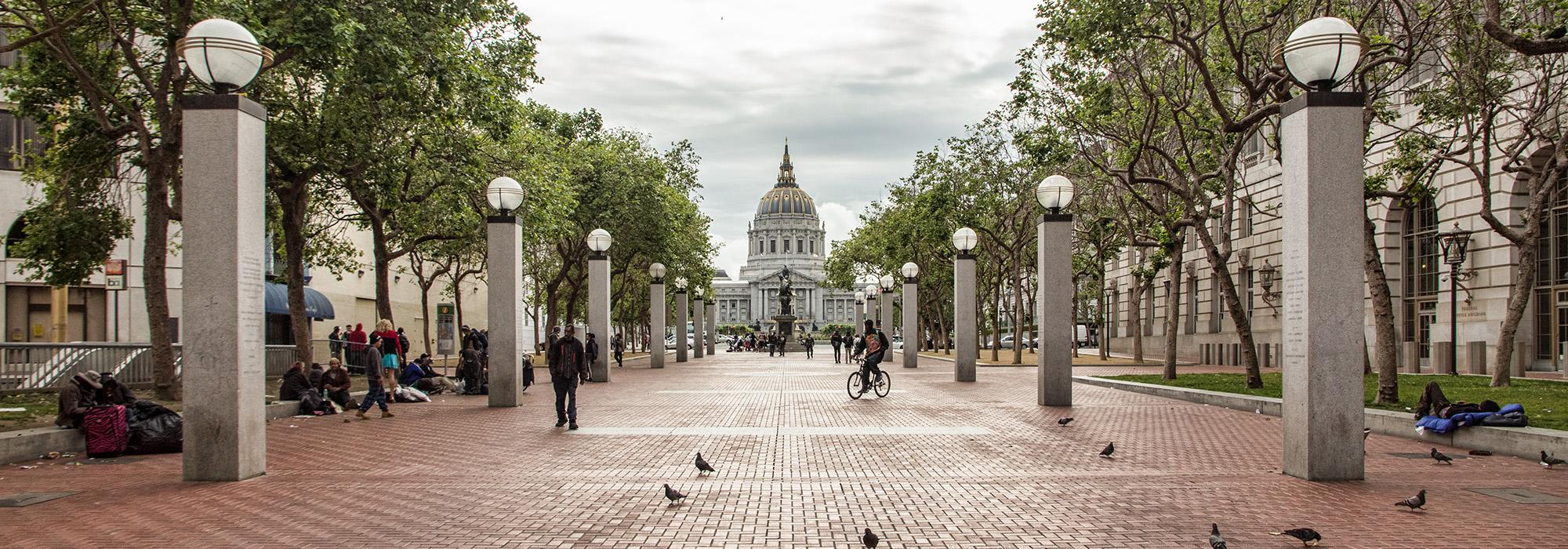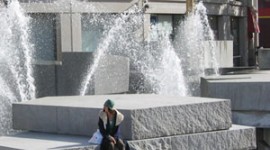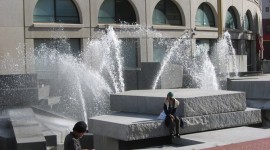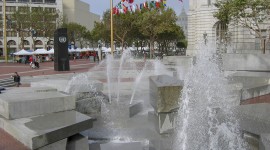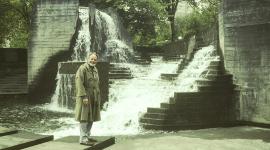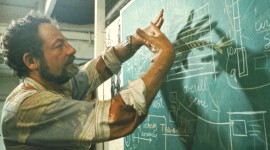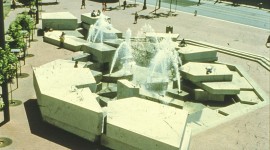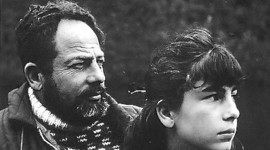Latest Plan to Revamp San Francisco’s U.N. Plaza Unveiled
On February 27, 2019, the San Francisco Planning Department presented a tentative plan outlining a major revamp of the Civic Center complex in downtown San Francisco, California. The proposal includes an overhaul of United Nations Plaza, designed in 1975 by landscape architect Lawrence Halprin and the architectural firms Mario Ciampi and Associates and John Carl Warnecke and Associates. Built beside Market Street to commemorate the signing of the 1945 Charter of the United Nations at the nearby Veterans War Memorial Building, the 2.5-acre brick-paved plaza, which serves as the gateway to San Francisco’s City Hall, includes Halprin’s signature granite fountain.
The latest proposal, which is still labeled as a “draft concept” and has yet to be described in great detail, aims at a more interactive fountain and public space and calls for an adaptation of the existing structure to increase visibility, accessibility, plantings, and adequate stormwater drainage. The lower level of the fountain is to be elevated slightly from its current depth and made accessible by the introduction of ramps. Water jets, which could be activated depending on programming needs, would be introduced at the lower level as an interactive element in the space. Unlike two of the three options initially presented to the Architectural Review Committee of the San Francisco Historical Preservation Commission on June 6, 2018, this one engages with Halprin’s design rather than destroying it.
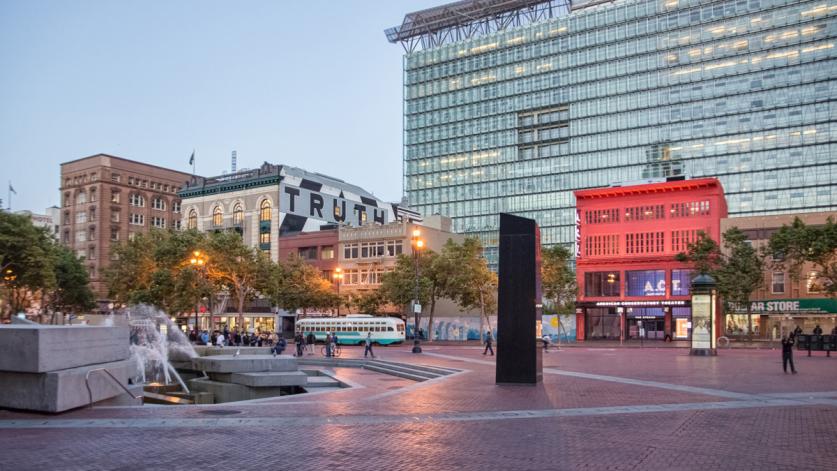
The result of some two years of public workshops and community outreach, the Civic Center Public Realm Plan also reimagines the Civic Center Plaza, the Main Library, the Asian Art Museum, and adjoining blocks of Market Street. The plan comes in the wake of public anxiety and criticism concerning the conditions at the Civic Center BART and Muni station. Located between the rapidly gentrifying Tenderloin and South of Market districts, the areas close to the station are often populated by people experiencing homelessness. In the early 2000s, benches were removed from the plaza to discourage lingering, and the fountain was shut down. Although rehabilitated in 2005, through grassroots efforts that returned the fountain to its full former exuberance (see image below), the sunken water feature is once again dry and now fenced off by metal barricades.
[Water] is something that is constantly moving and doing all kinds of things. I love to put fountains in because the sounds of the voices of the imagery that keeps on coming around all the time. And people love to sit around a fountain because of the sound of the water, and with children [because] they love to go into the water. And that's another thing that I always do and that is, I urge people to allow children to walk into the fountain. Don't have somebody go and say, “get out of the fountain, you're not supposed to be in it.” And you'd be surprised. Every time I do a fountain, the first thing I have to do is, the next week or so after I put it in, is tell the security people, get your asses out of here, they're allowed to be in the water.
- Lawrence Halprin, quoted from TCLF’s Lawrence Halprin Oral History, published in 2009
Built as part of the Market Street Reconstruction Project in conjunction with the underground BART system and station, United Nations Plaza is rich in symbolism and characteristic of Halprin’s dynamic and scenographic designs. The western end of the plaza features tree-shaded columns inscribed with the names of the United Nations member countries, as well as an equestrian statue of Simón Bolívar. Located on the eastern side of the plaza, the sculptural fountain is formed by 673 stacked, rough-shorn granite blocks and, when operational, is animated with arcing jets of water. It is meant to symbolize the seven continents of the world, tied to together by the oceans. The original design also incorporated computerized spray nozzles that could detect strong winds and reduce the water pressure accordingly to avoid spraying bystanders.
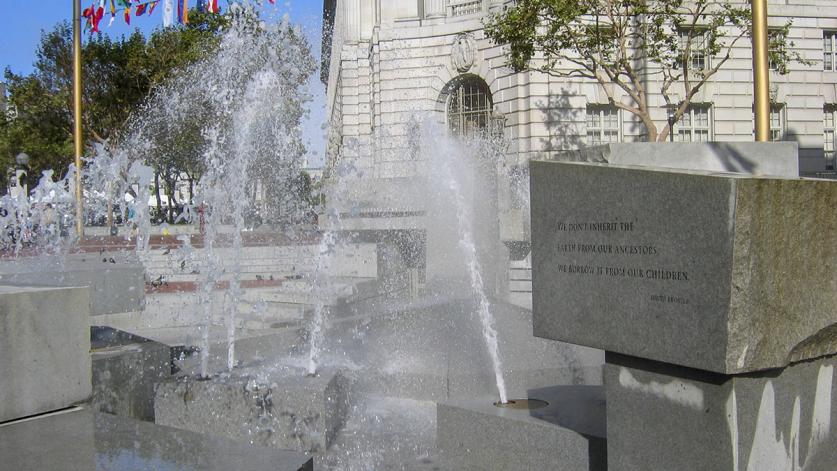
TCLF enrolled the United Nations Plaza in its Landslide program in August 2016 as part of a travelling photographic on Halprin’s life and career. Although the designed landscape is located within a National Register Historic District, the work associated with the area’s urban renewal is not currently included in the district’s designated period of significance. But United Nations Plaza is, in its own right, very likely eligible for listing in the National Register of Historic Places as an exemplary work of landscape architecture under Criterion C (“the Work of a Master”). Its sunken sculptural fountain is one of only a small number of surviving water features that Halprin designed in San Francisco, including a simple circular pool in Ghirardelli Square (1964); two fountains in Levi’s Plaza (1982), one at the park and one at the plaza; the 40-foot-high concrete fountain at the four-acre Justin Herman Plaza (1972), which is facing an uncertain future; and a career-capstone project, the boulder-lined lagoon at the Letterman Digital Arts Center (2005).
TCLF remains cautiously optimistic that, along with the new proposal’s historically sensitive approach to the Civic Center Complex, an equally sensitive approach will be employed with the plaza and its signature fountain, one that recognizes the design as a significant work of landscape architecture. The San Francisco Planning Department will continue to hold meetings and gather public feedback on the plan throughout the summer of 2019. If approved, the plan would then enter a phase of environmental review.



